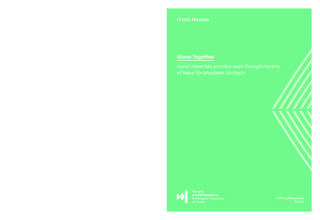| dc.description.abstract | The study examines different aspects of vocal ensemble practice, and explores the ways in which this practice differs from other classical vocal practices, like solo singing and choir singing. Vocal ensemble practice is described through the eyes and words of the members of the German ensemble, Neue Vocalsolisten Stuttgart. The empirical data upon which this thesis draws consists of a case study of the ensemble, including observations, semi-structured interviews, and participating observations. In addition to this case study of Neue Vocalsolisten Stuttgart, additional studies have been conducted for comparative purposes, including a study with interviews with Rogers Covey-Crump (singer in The Hilliard Ensemble) and John Potter (former singer in The Hilliard Ensemble). The theoretical framework of the study is focused on a range of theories of practice, including Wenger’s theories on Communities of practice and Shatzki’s theories of practices as an array of activities. In exploring various activities (or fields) within the practice, each is treated individually, with its own theoretical background, but always within the broader framework provided by the different theories of practice. The findings of the study suggest that vocal ensemble practice demands singers with special skills within the fields of intonation, communication, and ensemble vocal technique. The study shows how the ensembles studied, particularly Neue Vocalsolisten Stuttgart, deal with challenges within these fields. Other findings of the study relate to the organization of the ensembles’ work and to some of the social processes involved, for example the types of conflict which can arise and the ways in which the ensembles work to resolve these. The study shows how ensemble singers, including those of Neue Vocalsolisten Stuttgart, have worked hard to gain credibility as singers in an environment which attributes higher status to solo and operatic singing, and how they balance between working as soloists on one side and ensemble singers on the other. The unspoken hierarchy among singers and those who employ them, in which an opera soloist has higher prestige than, say, a chorister, means that the vocal ensemble singer has to balance between these two. More significantly, these entrenched attitudes to ensemble singing impact on the education of singers, who are encouraged to work towards operatic careers that can only be achieved by a very few, rather than for choral and ensemble singing, which provides a greater number of professional and opportunities for trained singers. This thesis concludes with recommendations for the development of educational practice based on the findings of the study, suggesting that singers of all kinds would benefit greatly from learning the particular skills required for ensemble singing, which are embedded in the distinctive practice it has evolved. | nb_NO |
